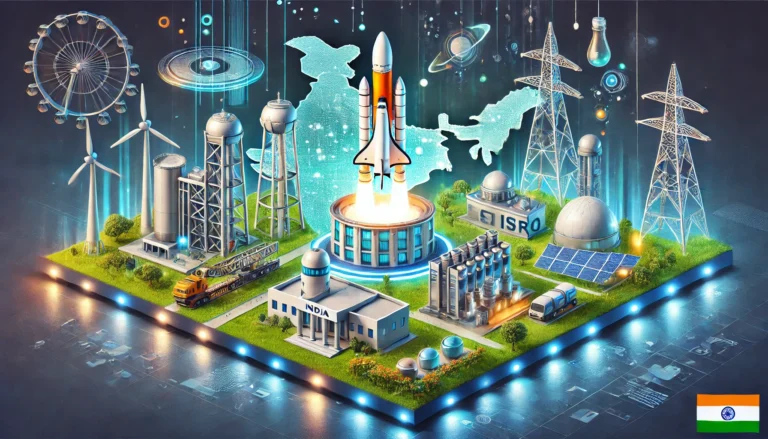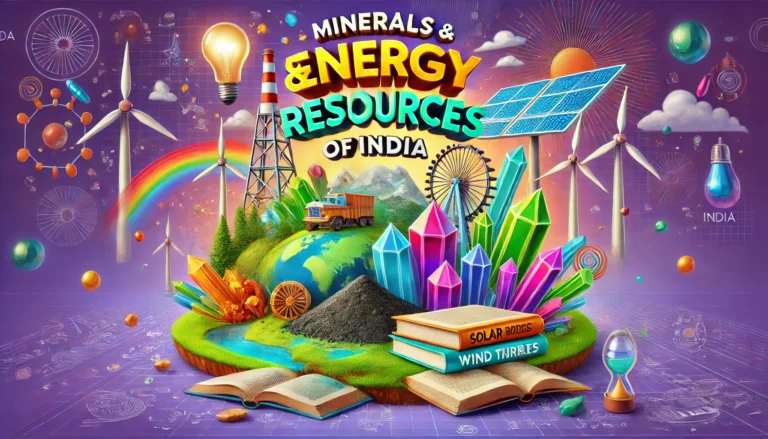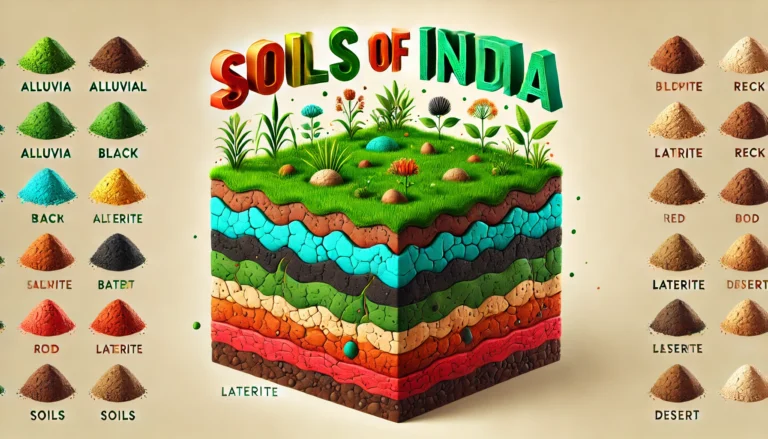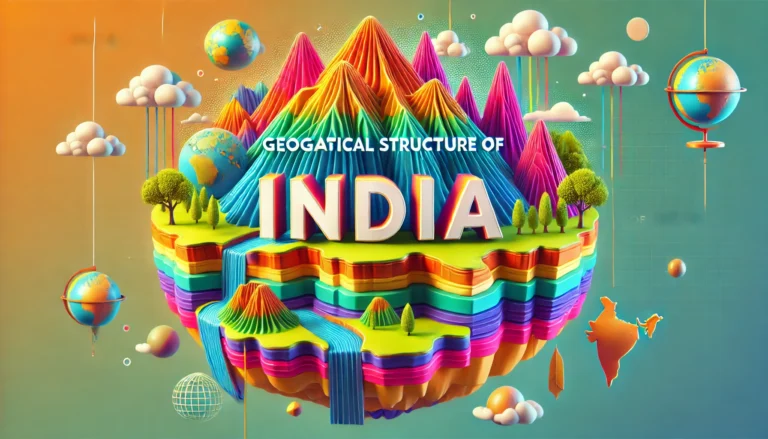The Climate of India: A Comprehensive Guide for Competitive Exam Preparation
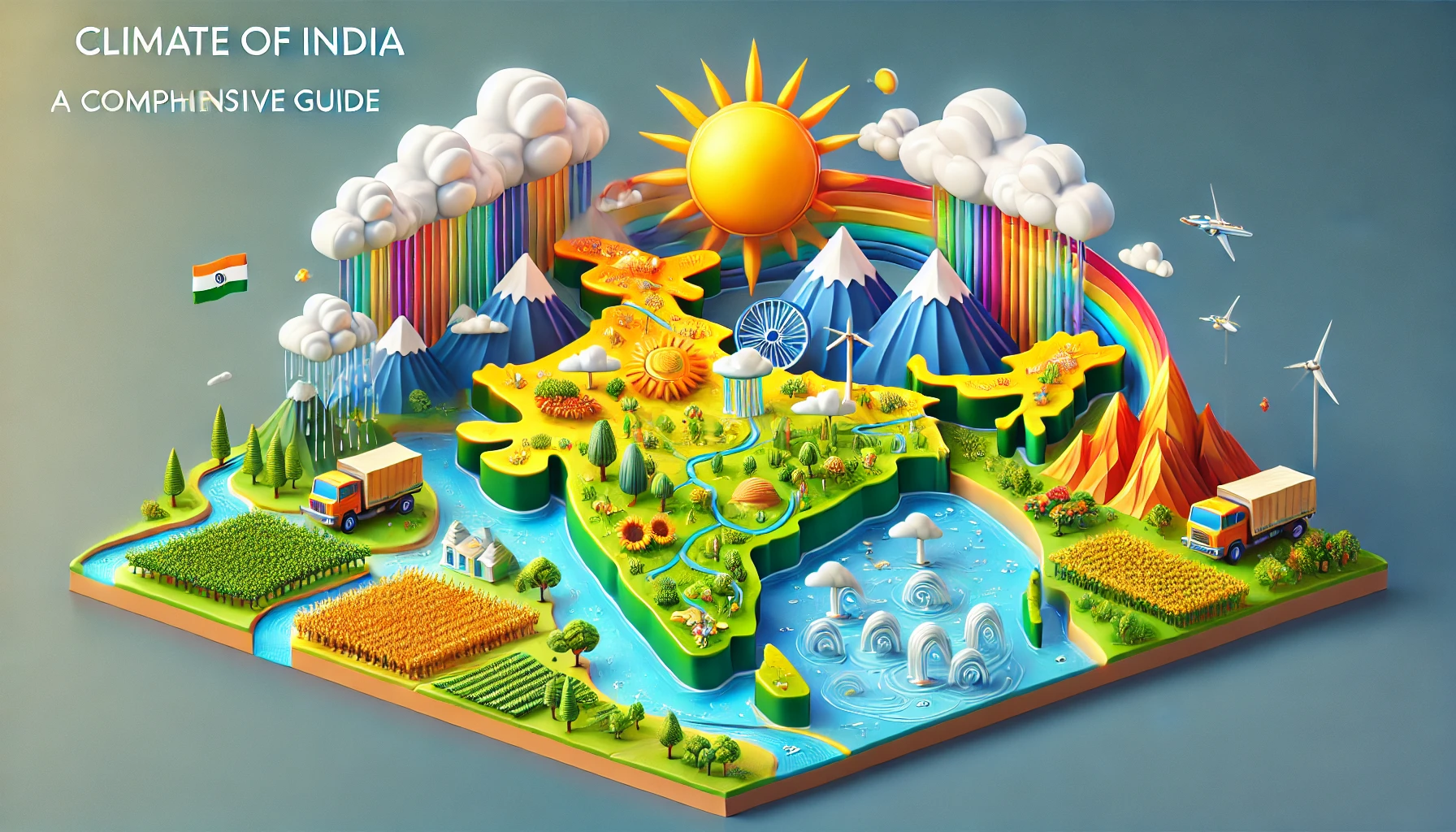
India, a land of diverse geography, boasts an equally varied climate. From the scorching Thar Desert to the frozen peaks of the Himalayas, India’s climate plays a vital role in its economy, culture, and biodiversity. For competitive exams, understanding the climate of India is essential as it forms a significant part of general studies and geography sections. Let’s dive deep into this fascinating topic.
Definition of Climate
Climate refers to the long-term average weather conditions of a place, typically observed over 30 years. It encompasses parameters such as temperature, humidity, precipitation, wind, and atmospheric pressure.
Factors Influencing the Climate of India
India’s climate is influenced by several geographical and atmospheric factors:
- Latitude:
- India lies entirely in the northern hemisphere between 8°4′N and 37°6′N latitudes.
- The Tropic of Cancer divides the country into tropical and subtropical zones, influencing temperature and precipitation patterns.
- Altitude:
- The Himalayan range blocks cold winds from Central Asia, ensuring a predominantly tropical climate in most parts of the country.
- High-altitude areas like Ladakh experience sub-zero temperatures year-round.
- Distance from the Sea:
- Coastal regions (e.g., Mumbai, Chennai) enjoy moderate maritime climates.
- Inland areas like Delhi experience extreme temperature variations due to the continental effect.
- Monsoon Winds:
- The Indian Monsoon is the lifeblood of the nation, bringing about 75% of the annual rainfall.
- The Southwest Monsoon and Northeast Monsoon play crucial roles in defining India’s climatic patterns.
- Pressure and Wind Systems:
- High and low-pressure zones, influenced by temperature differences, guide wind movements across the subcontinent.
- The Inter-Tropical Convergence Zone (ITCZ) shifts northward and southward seasonally, impacting rainfall distribution.
Seasons in India
India’s climate is characterized by four distinct seasons, as defined by the Indian Meteorological Department (IMD):
1. Winter (January to February):
- Temperatures range between 10°C and 15°C in northern plains; lower in the Himalayas.
- Cold waves and fog are common.
- Rainfall occurs due to Western Disturbances, benefitting rabi crops like wheat.
2. Summer (March to May):
- Temperatures soar above 40°C in many regions.
- Heatwaves, especially in northwestern and central India, are prevalent.
- Pre-monsoon showers (e.g., ‘Mango Showers’ in Karnataka) occur sporadically.
3. Monsoon (June to September):
- Marked by the onset of the Southwest Monsoon, bringing heavy rains to most parts of the country.
- Rainfall is unevenly distributed; regions like Cherrapunji receive over 11,000 mm annually, while Rajasthan’s Thar Desert remains arid.
- Monsoons are critical for agriculture, water resources, and hydroelectric power.
4. Post-Monsoon/Autumn (October to December):
- The withdrawal of monsoons leads to drier conditions.
- Northeast Monsoon brings rainfall to Tamil Nadu and Andhra Pradesh.
- Pleasant weather prevails in most parts of India.
Climatic Regions of India
According to the Koeppen’s Classification, India can be divided into the following climatic zones:
- Tropical Rainforest (Am):
- Found in Western Ghats, Andaman & Nicobar Islands, and northeastern states.
- High temperature and heavy rainfall throughout the year.
- Tropical Savanna (Aw):
- Predominant in peninsular India, including parts of Maharashtra and Madhya Pradesh.
- Distinct wet and dry seasons.
- Tropical Steppe (BSh):
- Covers regions like Rajasthan and parts of Gujarat.
- Semi-arid climate with low rainfall.
- Tropical Desert (BWh):
- Found in the Thar Desert region.
- Extremely high temperatures during summer; minimal rainfall.
- Humid Subtropical (Cwa):
- Northern plains, including Uttar Pradesh and Bihar, experience hot summers and cool winters.
- Mountain (H):
- Found in the Himalayan region with diverse climate zones depending on altitude.
Impact of Monsoon on Indian Economy
- Agriculture:
- About 60% of India’s cultivated area depends on monsoon rains.
- Monsoon failure leads to droughts, impacting crop yields and food security.
- Water Resources:
- Reservoirs, rivers, and groundwater recharge depend heavily on monsoonal rainfall.
- Energy Production:
- Hydroelectric power generation is closely tied to monsoon-fed reservoirs.
- Industry:
- Sectors like textiles, sugar, and beverages are directly affected by agricultural output.
- Infrastructure:
- Excessive monsoon rains often cause flooding, damaging infrastructure and disrupting transportation.
Important Climatic Phenomena
- El Niño and La Niña:
- El Niño events lead to weaker monsoons and droughts in India.
- La Niña enhances rainfall activity.
- Cyclones:
- Bay of Bengal and Arabian Sea witness tropical cyclones during pre- and post-monsoon periods.
- Cyclones like Amphan and Tauktae have caused significant destruction in recent years.
- Western Disturbances:
- These bring winter rainfall to northwestern India and are essential for rabi crops.
- Heatwaves:
- Frequently impact northern and central India during summer months, posing severe health risks.
Climate Change and Its Impact on India
- Rising Temperatures:
- Average temperatures in India have increased by 0.7°C from 1901 to 2018.
- Erratic Rainfall:
- Unpredictable monsoon patterns are affecting agricultural planning and water availability.
- Sea Level Rise:
- Coastal areas like Mumbai and Kolkata are at risk of inundation.
- Extreme Weather Events:
- Increased frequency of floods, droughts, and cyclones.
Key Takeaways for Competitive Exams
- India’s climate is influenced by geographical factors such as latitude, altitude, and monsoonal winds.
- Distinct seasons and climatic zones make India’s climate unique.
- The monsoon is pivotal to India’s agrarian economy and water resources.
- Climate change poses significant challenges to India’s environment and economy.
Understanding these aspects not only strengthens your preparation but also provides insights into the interdependence of climate, geography, and human activity in India. Prepare thoroughly, and you’re sure to excel in your exams!
1. Which one of the following dates is correct for the normal withdrawal of South-West Monsoon in Indian territory?
The South-West Monsoon normally starts withdrawing from the Indian territory by 15th September.
2. Which one of the following four periods corresponds with the withdrawal of South-West monsoon in most of Northern India?
The South-West Monsoon withdraws in most of Northern India during the period of October to November.
3. The monsoon responsible for rains in Jharkhand is?
The South-West Monsoon is responsible for most of the rainfall in Jharkhand.
4. Which one of the following sets of states does not receive most of its rainfall from South-West Monsoon during the months of June to September?
Tamil Nadu and Jammu and Kashmir receive most of their rainfall from the North-East Monsoon or other weather systems, not the South-West Monsoon.
5. The seasonal reversal of winds is the typical characteristic of?
The seasonal reversal of winds is a typical characteristic of monsoon climate.
6. Which of the following regions is not affected much by the Arabian Sea branch of monsoon?
The Chhattisgarh Basin is not significantly affected by the Arabian Sea branch of monsoon.
7. Which are the months for monsoon normally occurring in Tamil Nadu?
The monsoon in Tamil Nadu usually occurs during November-December, due to the North-East Monsoon.
8. Indian monsoon rainfall is affected by which of the following physical features?
The Indian monsoon rainfall is influenced by the Western Ghats, the Himalayas, and the Tibetan Plateau.
9. The Government of India in order to accurately predict monsoon, launched Monsoon Mission in?
The Monsoon Mission was launched in April 2012 by the Government of India to improve monsoon prediction accuracy.
10. Which one of the following is not associated with monsoon climate in India?
Western disturbances are not associated with the monsoon climate; they are linked with winter rainfall in North India.
11. South Arcot and Ramanathapuram receive over 50 percent of their annual rainfall from which one of the following?
South Arcot and Ramanathapuram receive most of their rainfall during the North-East Monsoon.
12. The state having the highest rainfall by North-East Monsoon is?
Tamil Nadu receives the highest rainfall from the North-East Monsoon in India.

